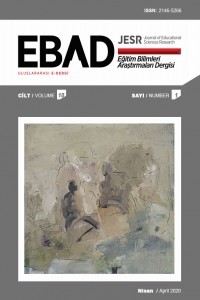Kayıp verilerin varlığında çoktan seçmeli testlerde madde ve test parametrelerinin kestirilmesi: SBS örneği
Kayıp veri, İhmal edilebilirlik, Seçkisiz kayıp, Kayıp veri yöntemleri, SBS
Item and test parameters estimations for multiple choice tests in the presence of missing data: The case of SBS
-,
___
- Acock, A. A. (2005). Working with missing values. Journal of Marriage and Family, 65, 1012- 1028.
- Allison, P. D. (2002). Missing data. California: Sage Publication, Inc.
- Allison, P. D. (2009). Missing data. Quantitative methods in psychology. (Edt: R. E. Millsao & A. Maydeu-Olivares). London: SAGE Publication. pp. 72-89.
- Baykul, Y. (2000). Eğitimde ve psikolojide ölçme: Klasik test teorisi ve uygulaması. Ankara: ÖSYM Yayınları.
- Crocker, L. & Algina, J. (1986). Introduction to classical and modern test theory. Belmont CA: Wadsworth Thomson Learning Company.
- Culbertson, M. J. (2011). Is it wrong? Handling missing responses in IRT. Annual Meeting of the National Council on Measurement in Education, April 2011.
- DeMars, C. (2002). Incomplete data and item parameter estimates under JMLE and MML estimation. Applied Measurement in Education, 15, 15-31.
- Demir, E. & Parlak, B. (2012). Türkiye’de eğitim araştırmalarında kayıp veri sorunu. Eğitimde ve Psikolojide Ölçme ve Değerlendirme Dergisi, 3 (1), 20-241.
- Dempster, A. P., Laird, N. M. & Rubin, D. B. (1977). Maximum likelihood estimation from incomplete data via the EM algorithm. Journal of the Royal Statistical Society, 39 (B), 1- 38.
- Elashoff, J. D. & Elashoff, R. M. (1971). Missing data problems for two samples on a dichotomous variable. Research and Development Memorandum, 73, 40-86.
- Enders, C. K. (2010). Applied missing data analysis. New York: The Guilford Press.
- Finch, H. (2008). Estimation of item response theory parameters in the presence of missing data. Journal of Educational Measurement, 45 (3), 225-245.
- Graham, J. W. (2009). Missing data analysis: making it work in the real world. Annual Review of Psychology, 60 (4), 549-576.
- Groves, R. M. (2006). Nonresponse rates and nonresponse bias in household surveys. Public Opinion Quarterly, 70 (5), 646-675.
- Hohensinn, C. & Kubinger K. D. (2011). On the impact of missing values on item fit and the model validness of the Rasch model. Psychological Test and Assessment Modeling, 53, 380-393.
- Linacre, J. M. (2004). Rasch model estimation: further topics. Journal of Applied Measurement, 5 (1), 95-110.
- Little, R. J. A & Rubin, D. B. (1987). Statistical analysis with missing data, 2nd ed. New York: John Wiley & Sons, Inc.
- Lord, F. M. (1974). Estimation of latent ability and item parameters when there are omitted responses. Psychometrika, 39, 247-264.
- Lord, F. M. (1983). Maximum likelihood estimation of item response parameters when some responses are omitted. Psychometrika, 48, 477-482.
- Lord, F. M. & Novick, M. R. (1968). Statistical theory of mental test score. California: Addison- Wesley Publishing.
- Mislevy, R. J. & Wu, P. K. (1996). Missing responses and IRT ability estimation: omits, choice, time limits, adaptive testing. ETS Research Report RR-96-30-ONR, Princeton, NJ: Educational Testing Service.
- Özçelik, D. A. (1981). Okullarda ölçme ve değerlendirme. Ankara: ÜSYM-Eğitim Yayınları:3.
- Puma, M. J., Olsen, R. B., Bell, S. H. & Price, C. (2009). What do when data are missing in group randomized controlled trial (NCE 2009-0049). Washington, DC: National Center for Education Evaluation and Regional Assistance, Institute of Educational Sciences, U.S. Department of Education.
- Rubin, D. B. (1976). Inference and missing data. Biometrika, 63 (3), 581-592.
- Rubin, D. B. (1987). Multiple ımputation for nonresponse in surveys. New York: John Wiley & Sons, Inc.
- Schaffer, J. L. (1997). Analysis of ıncomplete multivariate data. London: Chapman & Hall.
- Tekin, H. (2007). Eğitimde ölçme ve değerlendirme (18. baskı). Ankara: Yargı Yayınları.
- Item and Test Parameters Estimations for Multiple Choice Tests in the Presence Of Missing Data: The Case of SBS4 Ergül DEMİR5 Introduction
- Başlangıç: 2011
- Yayıncı: Kürşad YILMAZ
Mustafa İLHAN, Bayram ÇETİN, Meral ÖNER SÜNKÜR, Ferat YILMAZ
Kaynaştırma öğrencilerinin haklarına ilişkin sınıf öğretmenlerinin görüşleri
Funda NAYIR, Yasemin KARAMAN KEPENEKCİ
Seda OKUMUŞ, Sedat AYDOĞDU, Bilge ÖZTÜRK, Yasemin KOÇ, Oylum ÇAVDAR, Kemal DOYMUŞ
Okuduğunu anlamanın ölçülmesinde paragraftan anlam kurmaya dayalı çoktan seçmeli sorular
Yabancı dil öğretmeni yeterliklerinde kültür öğesi: Türkiye ve Çin karşılaştırması
Kadriye Dilek AKPINAR, Filiz METE
İlköğretim fen eğitiminde probleme dayalı öğrenme yaklaşımının üst düzey düşünme becerilerine etkisi
Tohit GÜNEŞ, Kazım ALAT, Ali İbrahim Can GÖZÜM
Doktora programı: Türk üniversiteleri doktora programları için bazı öneriler
